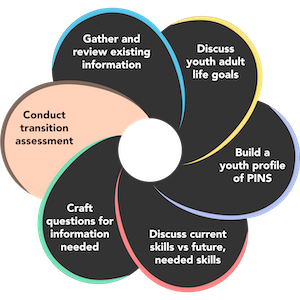Part One: What tools, methods and strategies will be used to address the assessment questions?
Sometimes, several assessment tools and methods are needed to gather data and information to thoroughly ‘answer’ just one of the questions. Other times an assessment tool can address several questions and assess a variety of skills at the same time. The questions are the anchors for the Transition Assessment plan. These questions allow everyone who is a part of the youth’s multi-agency team, including the youth and family, to take an active role in gathering transition assessment data and information.
Multiple Partners Can Contribute
The transition assessment process is beneficial not only for the youth, but also for the professional partners on the youth’s team. Partner agencies connected to the youth often have information and knowledge about the youth that can contribute to the transition assessment data. Each agency team member can then utilize the team’s collective information and data to complete their own required agency documentation. Using a team process to gather data results in a more comprehensive assessment, expedites agency processes and reduces duplication of effort for everyone involved.
Considerations for Tool Selection
It is important to take time to consider how the needed information will be gathered. No one tool or approach will be appropriate for all students nor environments. The student’s abilities and support needs will influence the selection of the appropriate tool. In short, how can the student show us what he or she knows? Also, one assessment tool cannot provide answers to all questions. The team should review the following questions in order to identify appropriate tools and methods.
Which Tools and Methods:
- Directly address one or more of the transition assessment questions
- Provide data that is valid for the area or domain being assessed
- Are compatible with the environment selected for assessment
- Are appropriate for the student, allowing the student to ‘show what they know’
- Are accessible to the youth? Culturally? Linguistically? Sensorially?
